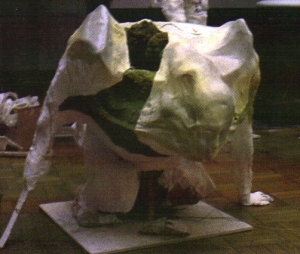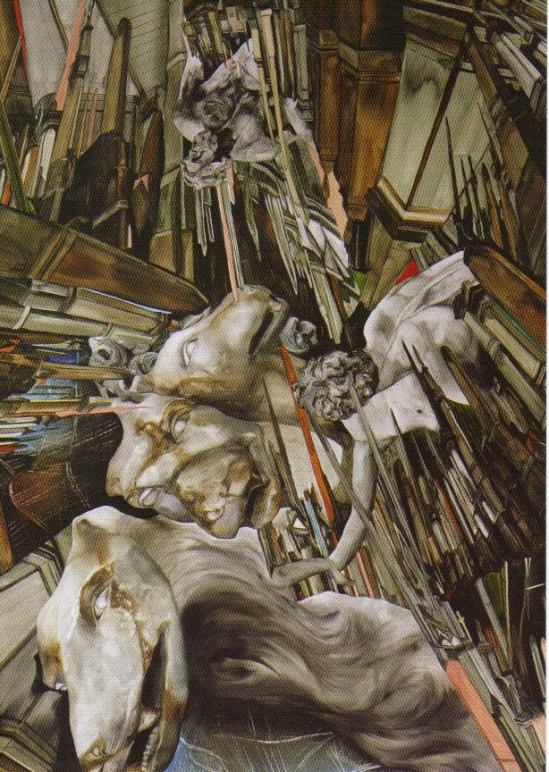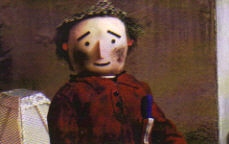Every year about this time, Glasgow School of Art holds its annual degree show – a collection of works by all the college’s students who are up for examination. It covers a wide spectrum of visual art – from painting, photography and sculpture to product and graphic design and video art. While there are always one or two ne’er-do-wells whose work seems half-arsed, the standard is usually very high. This year’s show is no exception.
Last year’s sensation was James Houston’s video remix of Radiohead’s “Nude”. Nothing this year has had the same impact on the world’s media. Things like that don’t come around too often.
I couldn’t hope to do the full show justice. I think I saw most, if not all of it. My method tends to be one of aimless wandering waiting for something to grab my attention. Sculpture usually seems the weakest form – often fairly aimless 3D collages, weird carpentry, ludicrous furniture or abstract shapes in bright primary colours. One fairly ghoulish piece consisted of a load of small sample vials suspended head height and labelled with a variety of noxious substances. Whether the garish coloured liquids, harmless looking crystals and powders were what they said they were is a moot point – asbestos, arsenic, cadmium, Hepatitis-B infected blood etc. You didn’t want to stand too close! I neglected to get the artist’s name – I was backing away too quickly. The other sculpture I really liked was by Kenneth Creanor. A twisted humanoid absorbed into rock with gaping holes in his back and side revealing a lush growth of moss. Disturbing.

Kenneth Creanor's humanoid rock sculpture
There wasn’t that much photography on show. The series that stood out for me were Jennifer Fergie’s giant prints of bleached out minerals, paper, chalk and wood chips. Reduced to postcard size they don’t have the same textural impact.
Painting remains the dominant medium in the Fine Arts section. What struck me generally was the dominance of surrealism, whether views of toilets in living rooms or bizarre juxtapositions of objects and figures, with Dali and Magritte’s playful influence cropping up all over the place. The most striking examples of this kind were the large, incredibly detailed canvasses by Rachel Wright. Classical and mythological figures loomed out of mazes of Doric columns, pinnacles and obelisks – some as sharp as spears – all radiating from different angles. The example on her promotional postcard that I’ve reproduced features a mean looking Cereberus, the three headed canine guardian of Hades.

One of Rachel Wright's classical nightmares
My favourite group of works were by Sophie Manhire. Her collection of stark paintings of doors and windows varied between impossible gloom, to barely sketched white. All devoid of all but the slightest of contrast. Their claustrophobic nature was highlighted by the central piece where a door opens to the outside, revealing the only colour. Instead of making it a bright, pastoral scene, the view was the forbidding browns and greens of an autumnal dusk. Even so, it was a glimpse of freedom amongst the gloom of the other pieces.
Of the installations, the two that stood out for me couldn’t have been more different. A whole wall was given over to a series of letters to various companies beginning “Dear Sir/Madam, My name is Harriet Lowther…” where she went on to praise everyday objects that she enjoyed – from her favourite brands of sweets to the Glasgow Subway. Also displayed were the replies that she got from harassed consumer departments, a mixture of bewilderment, corporate speak and genuine joy. Some were very funny (and she also seems to have got a lot of vouchers and freebies!). My favourite was her rather panicky second letter to Jessop’s, the camera people, in which she was alarmed that they were ‘investigating’ her comments! Sweet and funny, but also a worthy reminder of how people are quick to complain but very slow to praise.
Robbie Thomson’s dark room was the stuff of haunted house nightmares. The space was divided up by doorways that you could only find by touch. There was some light, but it was so dim that it only illuminated a few details. A sheet billowed in front of a fan whilst a cassette attached to a bewildering array of wires and rusty old circuitry provided a soundtrack of nightmarish creaks and groans. In one corner, a battered and modified piano with its strings exposed played a series of metallic drones. It was far too dark to work out how it was making the sound unaided. Dead spooky, though.
The product and graphic design sections were uniformly excellent. I liked the Faber film books whose covers were based on the tag cloud method of highlighting key themes and names. I also thought Aidan Watson’s portable hydropower mechanism was genius. It’s a small water turbine attached to a float that you place in a fast moving stream or small river, and it will generate electricity to recharge your laptop or mobile phone. A little bulky for hikers, perhaps, but a boon for people who are camping or working in areas a long way from reliable mains electricity. I hope someone takes the idea up – it has the potential to be as iconic as Trevor Baylis’s clockwork radio.
Finally, a mention for Joseph Mann’s stop-motion animated short “The Chimney Sweep”. It’s a delightful, heart-warming little film featuring a sweep who loses his lunch whilst sat on a roof, and a little boy with a model aeroplane. I’ll not give the plot away! (you can see the film at josephmann.co.uk)

A scene from Joseph Mann's delightful animated short "The Chimney Sweep"
The show continues until Saturday 20th June at the Glasgow School of Art, between 10.30 and 4.30. Get down if you can.

